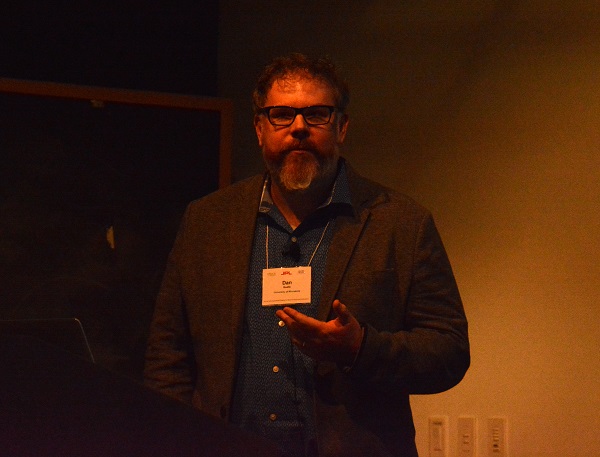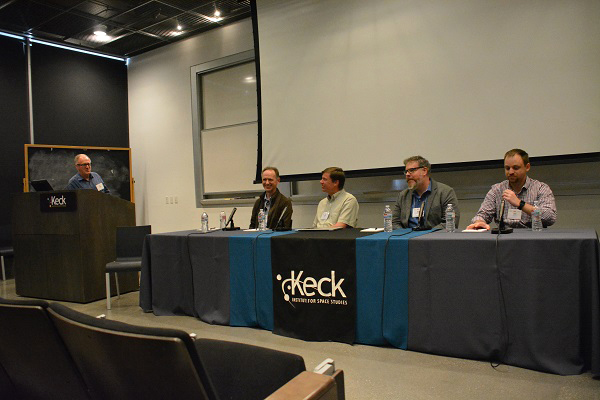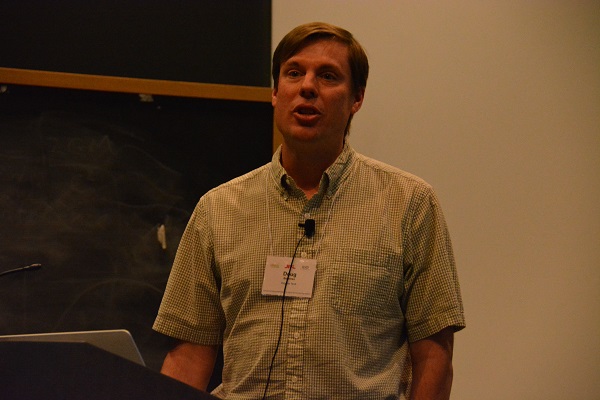by Dot Cannon
“You have to learn to think in 3D,” said Professor Daniel Keefe. “You’re no longer painting on a page. You’re painting in space.”
Attendees to Caltech’s recent ““Virtual and Augmented Reality for Space Science and Exploration” symposium, at Keck Institute of Space Studies in Pasadena, had returned from their mid-morning coffee break.

And Professor Keefe, who is an Associate Professor in the University of Minnesota’s Department of Science and Engineering, was showing them how virtual reality could work in three different areas. First, he explored Lift-Off, an immersive interface for artists, architects and engineers.
“The same way you’d sketch on the back of a napkin, you sketch in VR,” he explained.
Keefe’s research, according to his speaker summary, centers on both scientific data and interactive computer graphics. While discussing Lift-Off, he addressed the idea of incorporating something created in the “real world”, into a 3D creative space.

“What if you have some sketches or a notebook?” he asked. “We can import hand-drawn sketches and pull them into a 3D space.”
But graphics weren’t the only creative area Keefe would address, during his presentation. He and his colleagues had also used a platform called Bema, to reconstruct conditions facing orators in ancient Greece.
Using a wireless sensor attached to glasses, he said, they determined the challenges those speakers would have encountered, when addressing more than 6,000 people without a microphone. And the immersive technology had allowed one of his colleagues to identify a mistake the group had made within five minutes.

“There’s a sense of presence and judgement scale that’s just there immediately (in VR),” Keefe explained.
He also gave a final example of the use of virtual reality: in the medical field. Using a platform called Bento Box, he said, medical-device designers could compare and analyze cardiac data.
“Why are we doing this? These are very complex data sets,” Keefe said. “When you sit in VR, things start to fall into place spatially.”
VR: A “thinking space”
“Why immersive VR?” asked Virginia Tech Director of the Center for Human-Computer Interaction Doug A. Bowman.
“Let me start by asking the opposite question. Why not immersive VR?”
Dr. Bowman, who is Virginia Tech’s Frank J. Maher Professor of Computer Science, highlighted the sense of presence which virtual reality allows users, in his presentation.
Virtual-reality space’s 3D capabilities, he said, afforded infinite “space to think”. Users could lay out and analyze large quantities of data, compare what they saw and find links or similarities.

“We think…analytics (need) to be not just people looking at data…and not just machines looking at data…but a collaboration, between people and machines.”
Bowman explained a proposal involving VR: immersive space to think, or IST. Giving an example of an employee verifying news stories for a large social-media company, Bowman stepped his audience through the ways this system could work.
“(Let’s say) the first (news) claim is that police fired rubber bullets (into a crowd of protestors),” he said. “(The user highlights this information) with her virtual pen. The system collects the top 100 posts (about the incident). It tags the most relevant posts…(and) arranges them, to determine credibility.”
Four perspectives on VR
The morning ended with a panel of four experts: Dr. Wolfgang Stuerzlinger, Dr. Doug Bowman, Professor Daniel Keefe, and Professor Alex Endert. As symposium co-organizer Dr. S. George Djorgovski moderated, each shared impressions of the morning’s presentations and takeaways.

“None of us really talked about augmented reality,” observed Dr. Bowman.
“I found (the way) Doug used VR as a place to organize our space when working, refreshing,” commented Professor Endert.
Professor Keefe said that incorporating virtual reality into a workspace required room to explore.
“The ultimate task, based on what I’m seeing, (is) how do I adjust things,” he said. “You have to get your hands (on) and you have to ask questions.”

Dr. Stuerzlinger pointed up a consideration for artists in virtual reality.
“I think sketching is fundamentally different. It’s much more ephemeral, and that’s the point,” he said. “If you kill that, you kill exploration in the design space.”
And bringing VR into our everyday world was the main idea, Dr. Bowman said. “I think everything we’re talking about can be summed up as, how do you make these immersive environments work for people?” he said. “I think we’ve got to (work towards) a future where I wear something (as nonintrusive as a pair of glasses to make VR work). Where it’s seamless.”

Lunchtime had arrived. Attendees broke to eat, network–and perhaps get some pictures of the morning’s speakers.
And the afternoon program? Still to come were: a look at building spacecraft through augmented reality; a virtual-reality exploration of Mars; and a look forward at the ways AR and VR could change the future.
This is part 2 of a 4-part series. Missed Part 1? Check out this link.

